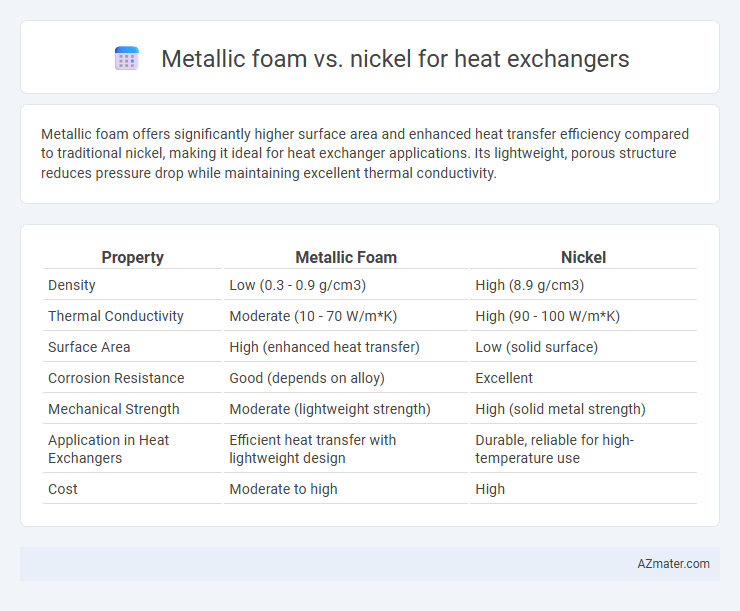Metallic foam offers significantly higher surface area and enhanced heat transfer efficiency compared to traditional nickel, making it ideal for heat exchanger applications. Its lightweight, porous structure reduces pressure drop while maintaining excellent thermal conductivity.
Table of Comparison
| Property | Metallic Foam | Nickel |
|---|---|---|
| Density | Low (0.3 - 0.9 g/cm3) | High (8.9 g/cm3) |
| Thermal Conductivity | Moderate (10 - 70 W/m*K) | High (90 - 100 W/m*K) |
| Surface Area | High (enhanced heat transfer) | Low (solid surface) |
| Corrosion Resistance | Good (depends on alloy) | Excellent |
| Mechanical Strength | Moderate (lightweight strength) | High (solid metal strength) |
| Application in Heat Exchangers | Efficient heat transfer with lightweight design | Durable, reliable for high-temperature use |
| Cost | Moderate to high | High |
Introduction to Heat Exchangers
Heat exchangers are critical devices designed to efficiently transfer heat between two or more fluids, often optimizing thermal management in industrial processes. Metallic foam offers a high surface area-to-volume ratio and excellent thermal conductivity, enhancing heat transfer rates compared to traditional solid metals like nickel. Nickel's corrosion resistance and structural strength make it suitable for harsh environments, but metallic foam's lightweight and porous structure provide improved fluid flow dynamics and thermal performance in heat exchangers.
Overview of Metallic Foam Materials
Metallic foam materials, composed of porous metal structures like aluminum or nickel alloys, offer superior thermal conductivity and enhanced surface area for efficient heat exchange in heat exchangers. These lightweight foams provide excellent mechanical strength combined with high permeability, facilitating improved fluid flow and heat transfer compared to solid nickel components. Their unique cellular architecture enables better thermal management in applications requiring rapid heat dissipation and reduced weight, outperforming traditional solid nickel materials in many heat exchanger designs.
Nickel in Heat Exchanger Applications
Nickel exhibits exceptional corrosion resistance and high thermal conductivity, making it ideal for heat exchanger applications in harsh chemical environments. Its mechanical strength and oxidation resistance enable long service life, especially in high-temperature operations found in power plants and chemical processing. Compared to metallic foam, solid nickel provides superior durability and consistent heat transfer efficiency under extreme conditions.
Thermal Conductivity: Metallic Foam vs Nickel
Metallic foam exhibits lower thermal conductivity compared to solid nickel, typically ranging from 10 to 40 W/m*K depending on porosity and material composition, whereas pure nickel has a thermal conductivity of approximately 90 W/m*K. The porous structure of metallic foam enhances heat transfer through increased surface area and turbulent flow, compensating for its reduced intrinsic conductivity. Nickel remains advantageous in applications requiring high thermal conductivity and mechanical strength, while metallic foam offers superior heat exchange efficiency through enhanced convective heat transfer.
Mechanical Strength and Durability Comparison
Metallic foam exhibits superior mechanical strength due to its high strength-to-weight ratio and energy-absorbing structure, making it highly resistant to deformation under mechanical stress in heat exchangers. Nickel, while possessing excellent corrosion resistance and high temperature durability, generally demonstrates greater hardness but lower impact resistance compared to metallic foam. In terms of durability, metallic foam's porous architecture enhances thermal shock resistance and fatigue life, whereas nickel's dense microstructure provides better long-term stability in chemically aggressive environments.
Corrosion Resistance in Heat Exchanger Environments
Metallic foam and nickel exhibit distinct corrosion resistance profiles in heat exchanger environments, where nickel's superior resistance to oxidation, acids, and alkaline media makes it highly favorable for long-term durability. Metallic foam, typically composed of aluminum or steel alloys, offers high surface area and thermal conductivity but can be more susceptible to localized corrosion and pitting in aggressive fluids. Selecting nickel ensures enhanced lifespan and reduced maintenance due to its robust passivation layer, whereas metallic foam requires protective coatings or treatments to withstand corrosive heat exchanger conditions effectively.
Weight and Structural Efficiency
Metallic foam exhibits significantly lower density compared to solid nickel, resulting in substantial weight reduction for heat exchanger applications while maintaining adequate mechanical strength. The high porosity of metallic foam enhances structural efficiency by providing a favorable strength-to-weight ratio, improving thermal performance without compromising durability. Nickel, though denser and stronger in bulk form, often leads to heavier and less weight-efficient heat exchanger designs compared to lightweight metallic foam alternatives.
Manufacturing Process and Cost Analysis
Metallic foam heat exchangers are produced using methods like powder metallurgy, investment casting, or additive manufacturing, offering complex geometries and high surface area but with higher fabrication complexity and cost. Nickel heat exchangers are commonly manufactured through conventional processes such as casting, machining, or electroforming, resulting in a more straightforward production with lower material and processing expenses. The cost analysis reveals metallic foam typically incurs higher initial manufacturing costs due to intricate production techniques, while nickel excels in cost efficiency but may offer less enhanced thermal performance compared to porous metallic foam structures.
Applications and Industry Adoption
Metallic foam offers superior heat transfer efficiency and lightweight properties, making it ideal for automotive and aerospace heat exchangers where weight reduction is crucial. Nickel heat exchangers excel in chemical processing and power generation industries due to their exceptional corrosion resistance and high-temperature stability. Industries adopting metallic foam prioritize enhanced thermal performance and energy savings, while sectors using nickel focus on durability and long-term operational reliability.
Future Outlook: Innovations in Heat Exchanger Materials
Metallic foam offers superior thermal conductivity and enhanced surface area compared to traditional nickel, making it a promising candidate for next-generation heat exchangers. Innovations in alloy composition and additive manufacturing enable customizable pore structures in metallic foams, optimizing heat transfer efficiency and reducing weight. Future research focuses on improving corrosion resistance and mechanical strength, positioning metallic foam as a versatile alternative to nickel in high-performance heat exchanger applications.

Infographic: Metallic foam vs Nickel for Heat exchanger
 azmater.com
azmater.com